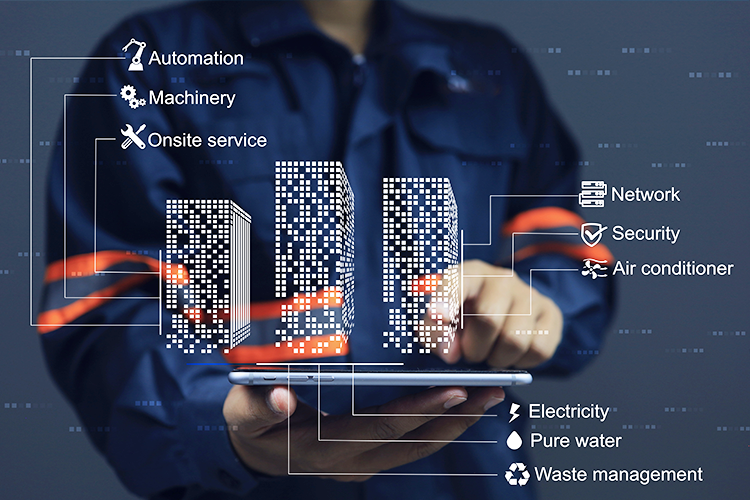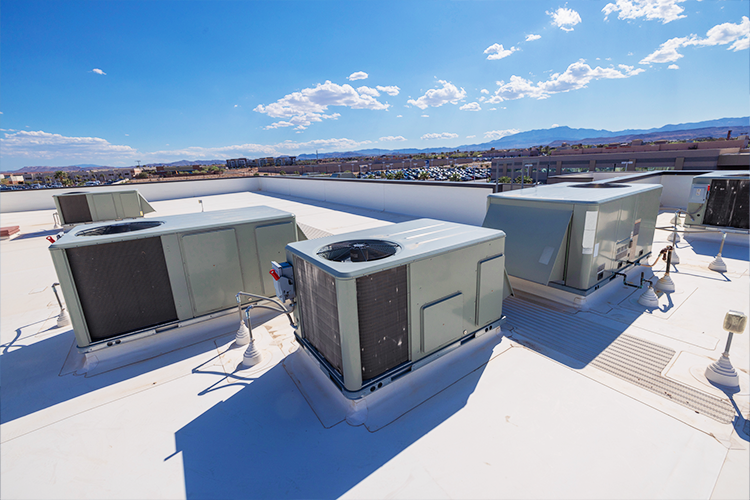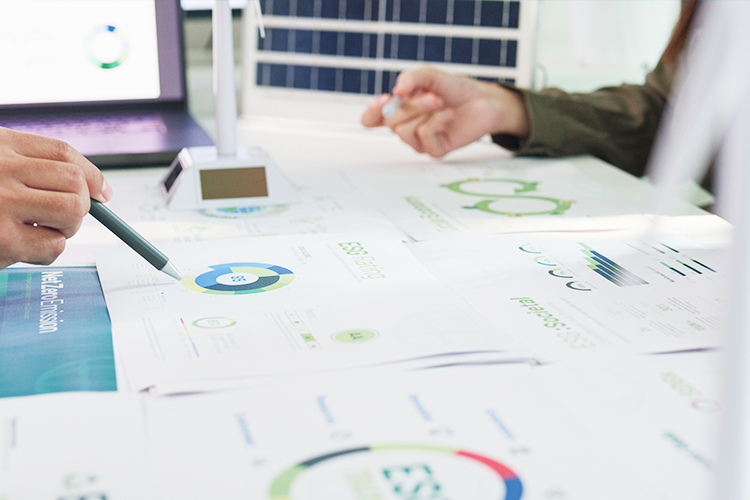What's New on the DLC: Highbays
March 11, 2014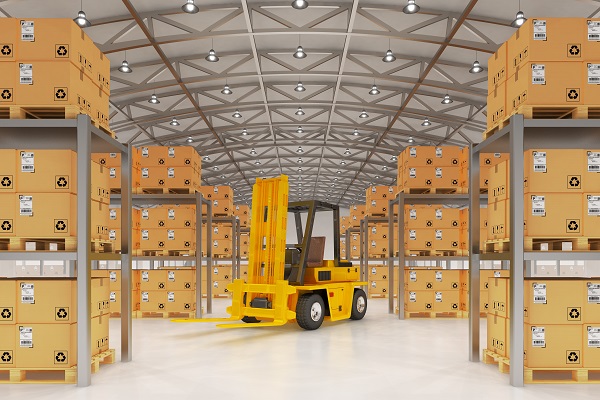
As I mentioned in my “What’s New on the DLC” introductory post, I’m going to work my way through the seven categories on the Qualified Products List (QPL). We’ll start with highbays. Have a look at the chart below. Get familiar with it as you’ll see a lot of them in this blog.
Highbay Efficacy Over Time
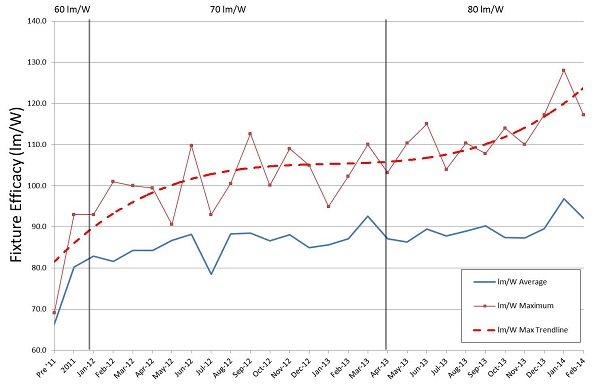
This chart shows a few things:
- Allowable Luminaire Efficacy (per the DLC technical requirements) – Minimum value shown at the top of the chart, which DLC updates every 12-18 months.
- Blue Line – The average efficacy of each new qualifying highbay luminaire each month.
- Red Line – The maximum efficacy of all new qualifying highbay luminaire each month.
- Red Dotted Line – The trend line of the maximum highbay luminaire efficacy.
Looking Back
This chart, as well as the analysis of the data behind it, shows us some pretty interesting trends.
When it comes to fixture efficacy we are getting a couple different stories. The average of all highbays being qualified each month has barely changed in the last 20 months. However, the maximum each month was fairly flat for the first 12 of those 20 months, but it has certainly trended upward over the last six to eight months.
So why is the average “stuck” where it is (~90lm/W)? I think there are three main reasons why:
Fixture manufacturers have focused on cost reduction measures instead of efficacy. This is the biggest reason in my opinion, and I can’t argue with their success. Over those 20 months, the cost of a good highbay fixture has roughly been cut in half. I talked about them accomplishing this in my 2013 Predictions and Look Back blogs.
A lot of fixture manufacturers seem to think 80-90lm/W is good enough. At the start of the 90lm/W flat line, 55-60% of the fixtures that hit the DLC list were coming in above the average lm/W of the group. That number has plummeted to 35-40%. Basically there used to be more premium products that were pulling up the average of the less efficient ones. Now there is a glut of “good enough” fixtures pulling down the average of the premium products that are hitting the market.
While 80-90 lm/W technically is “good enough” to get on the DLC list, for a company like EMC, it hasn’t proven to be good enough for widespread adoption. Price is a big lever in the payback equation, but it’s not the only one. When you shift that discussion away from payback and more toward Total Cost of Ownership (TCO) paying a little more money for a premium (110+ lm/W) product is the better option.
Some highbay fixture manufacturers have focused on aesthetics. I commend them for that. It’s easy to assume that aesthetics don’t matter for highbay fixture. In order to get to that 100lm/W plateau 20 months ago, some aesthetic shortcuts needed to be taken.
Efficacy trumped glare reduction. For some facilities it didn’t matter, but for many it was a barrier to adoption. With glare reduction comes less optical efficiency of the fixture, which pulls down its efficacy. This branch of premium fixtures that has started to hit the market is “stuck” for now at that 90-100lm/W, but the glare control of these fixtures has opened the door to the retail highbay market.
More Metrics!
There are a few other metrics that I am tracking.
Color Rendering Index (CRI). The minimum allowable CRI, per the DLC is 70. The monthly average over the length of the DLC list has been in the mid to upper 70s. Most fixtures come in around 75 with a couple outliers in the mid 80s.
L70 Hours. Starting in mid-2011, this rating became a requirement for fixtures on the DLC list. DLC required that fixtures degrade no more than 30% over the first 35,000 hours of operation. The requirement remains the same today, but now, just like as it was back in 2011, very few fixtures flirt with the 35,000 minimum. In fact, only a few fall below 50,000.
The interesting change over time is that early on, there was a race to the top 100,000… 200,000…300,000 hours! Those numbers end up becoming meaningless because other parts of the fixture will fail well before that time frame. More and more, fixture manufacturers are publishing numbers that are more meaningful for the lighting design community: L80, L90, and L95 hours ratings. L70 was the original standard for rating LED lifetimes, but it’s becoming obsolete. It would be interesting if the DLC upped their requirement to an L80 standard.
Warranty. I thought this might be more interesting than it has been so far. Since the DLC started requiring a 5 year warranty for fixtures, 95% of the fixtures have come in with a 5 year warranty. There are a few each month with 7 or 10 year warranties, but not enough to move the average very much.
What’s New?
Over the last three months we have seen 14 new Highbay products hit the market that are over 110lm/W. Before that, only five highbay fixtures had reached that efficacy level. Fixture manufacturers are seeing an opportunity to grab that Total Cost of Ownership market rather than solely focusing on a payback model.
One of the great things about digging into the DLC like this is that it becomes a bit of a preview of things to come. What’s newest on the DLC QPL list probably hasn’t actually hit the market yet. Companies want to get DLC qualified before they release the product. Sometimes I suspect that lag will be short, but other times it may be long. It will be interesting to watch.
The current leader of the highbays is POSCOLED #PHBCH855W2B10, coming in at 128lm/W. POSCOLED is a Korean company that I am not familiar with and can’t find all that much about. Additionally, I can’t find a cutsheet for this product, which probably means it’s not released yet. It’s not a particularly high total lumen output (11560lm), which I would classify more as a Lowbay. Second place on the list (eLumen #HBX125C) is from a Canadian company, and while I have found and navigated their website, I’m not able to find a cutsheet for that fixture.
The highest lm/W fixture that I can find good info for is Meteor Lighting’s #CS-115-CW. I’ll give it the prize as the current available leader for “low output” Highbays, as it’s just over 12,000lm. The current leader for “high output” highbays would be Cree’s #CXB-23L, which comes in around 25,000lm.
Where are We Going?
I suspect some time in 2014 we will see the DLC raise their efficacy requirement to 90lm/W. This will have a big effect on the average. Over half of the Highbay products that qualified in February (25 of 48) fell below 90lm/W. If you took those out, the average would be 101lm/W. As for the top end products, I wouldn’t be surprised if we see a product released in the next six months that hits the 150lm/W threshold.
I don’t see the other metrics moving much this year unless the DLC amends their requirements. There will be Highbay products that come in with a higher CRI to try to capture some of the retail market, but the majority of the products are targeted to warehouses and manufacturing. 70 CRI is just fine for those spaces.
I don’t see the DLC changing their warranty requirements. The only place to go would be seven years and I think the industry would really push back on that. As for L70, I think it would be a good change to go to L80, or even L90. The hours could be lowered if they went to a L90 model, but it would push the industry to a place that lighting designers would like it to go, which is providing more meaningful information rather than information targeting an outdated standard.
Tony Johnson is Energy Management Collaborative's Technology Manager. In this role he combines his background in lighting & controls design and solid state light fixture design with his expertise in energy savings to evaluate emerging technologies for EMC customers.
